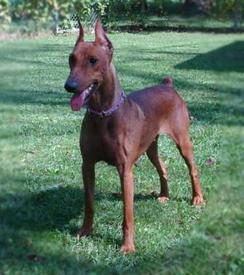
This article also relates to: Miniature Pinscher
Hailing from Germany at a date unknown, the German Pinscher features in literature and paintings from as early as 1780, appearing alongside farmers and townsmen. Originally utilised in ratting about the home and farmstead, helping to remove vermin from premises that stored food, the Pinscher was also observed as a coach guardian or serving as a carriage dog. The breed was nearly destroyed with the onset of WWI when privations meant that breeding stock diminished, however it was resurrected by Werner Jung, a German fancier, and has continued to develop ever since. Falling within the 'working' breed group, the German Pinscher shares its classification with the Boxer, St. Bernard and Great Dane and was officially recognised by the American Kennel Club in 2003.
Compact in size with an athletic frame, the German Pinscher is believed to have contributed to the evolution of the Doberman, Affenpinscher and Standard Schnauzer, with distinctive characteristics reflected in its descendents. The Pinscher is identified by its small and proportioned head, body and legs, high-set ears and slight muzzle. Despite being an illegal practice in most parts of Europe, tail 'docking' and ear 'cropping' are commonly observed in the breed, although it is not a breed standard. The coat is typically short and smooth, in colour variations of red, fawn, brown, black and yellow, with black and tan being the most common.
...has retained its instinctive prey drive, is active, versatile and intelligent. In order to get the best from your Pinscher, regular exercise, mental stimulation and human companionship are essential. Early training, socialisation and leadership will also benefit the Pinscher, a breed that thrives on activity of any kind, engages well with children and happily responds to instruction. The German Pinscher is a great breed choice for the active family or dedicated sole owner, weighing an average of 11-16 kg, with a life expectancy of 12-14 years.
Notoriously healthy, the German Pinscher is relatively low maintenance when it comes to supporting optimum health and condition. As with most breeds, hip dysplasia and optical disorders are identified in the Pinscher, as are behavioural issues associated with its small proportions.
Do you own a German Pinscher? Let others know what they're like!
Related products
Trixie Muzzle for Dogs Black
from £2.95
Dog Gone Smart Suede Quilted Belly Coat Red
from £15.89
KONG Anxiety Reducing Shirt for Dogs
from £16.63
Pawz Natural Rubber Dog Boots
from £9.99
Advantage 80 Spot On Flea Control Large Cats and Rabbits
from £12.95
Advantage 40 Spot On Flea Control Cats, Small Dogs and Rabbits
from £12.95
Advantage 250 Spot On Flea Control Large Dog
from £12.95
Advantage 100 Spot On Flea Control Medium Dog
from £12.95